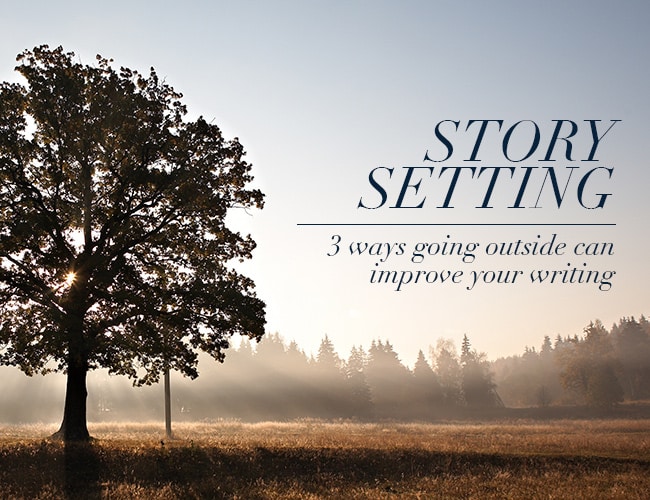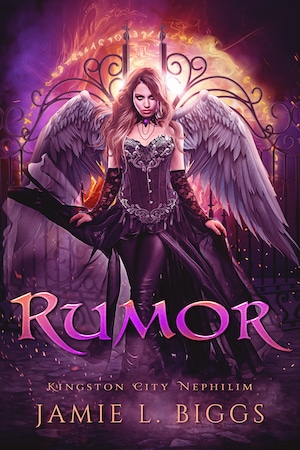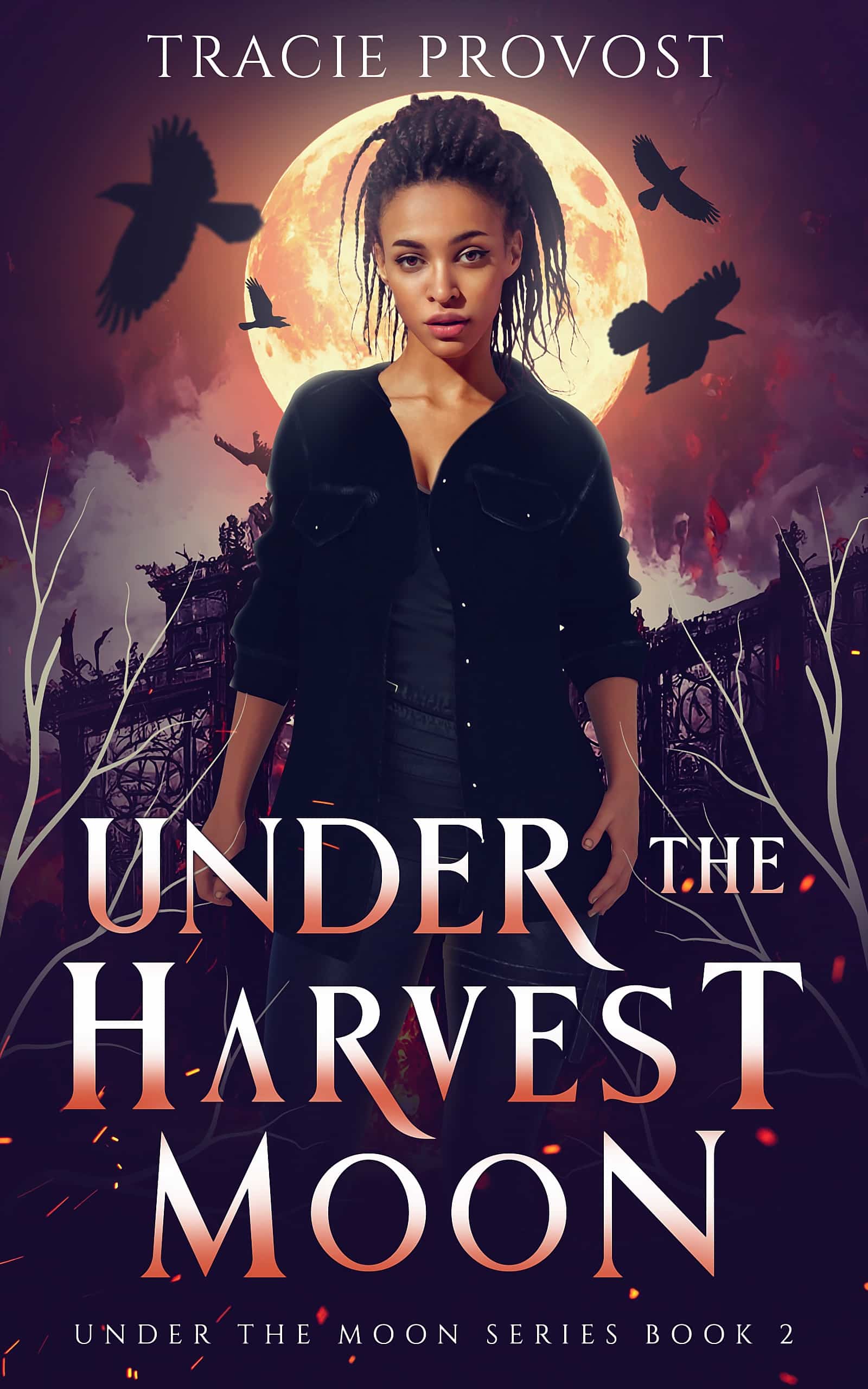Our job as writers is to transport our readers into our stories. A high-octane plot and three-dimensional characters are obviously necessary to accomplish this goal, but so is an immersive setting of a story.

The setting of a story is often overlooked when describing a scene. We all want to move on to the next plot twist and wasting important space on what trees look like will just bore the readers, right?
Wrong.
To draw readers fully into a scene, we need setting. We want them to forget they’re reading and make them experience everything our characters are experiencing.
Sometimes, you can get away with building the setting of a story straight from your imagination. Sometimes, you can’t.
The Argument for Going Outdoors
I’m what you would call an “outdoorsy person.” I love being outside in any weather, at any time of day. Nature inspires me, clears my head, and gets me out of my desk chair for a little while.
You don’t have to be a nature person to get the benefits of absorbing your surroundings. And you don’t have to live in the middle of the woods to write about the outdoors. Even sitting on your porch or taking a quick jaunt around the block can infuse you with new energy and enthusiasm.
3 Ways to Be More Present
Okay, you’re outside, standing on a hill, looking at the sunset. Now what?
We’re constantly surrounded by everything we need to build a great setting of a story, but we often ignore all that in our rush to the next thing.
Pay attention to your surroundings. Immerse yourself in your own experiences, and you’ll be able to draw on them later.
NOTE: I’ve used a rural setting as an example, but this applies to urban settings as well.
Here are three things to think about while outdoors:
1. Your Senses
You already know the importance of using all five senses to improve your writing, but it can be hard to notice anything deeper than the obvious.
Let’s take our sunset example from earlier. It’s obviously gorgeous, and you can probably describe the colors of the sunset quite well.
Look deeper.
Close your eyes. Can you hear someone crunching through the woods in the distance? Songbirds? Traffic? The woman walking her dog across the field: Is she slumped from cold or fanning herself from heat? Young, old, talking on her cell phone? Is she attentive to her dog or zoned out? What does the air smell like? What does the ground feel like?
Pay attention to the less obvious and you’ll draw in your readers.
Remember: You don’t have to use all five senses in every description. Select the most useful senses for the scene.
PRO TIP: Try observing the same setting at different times of day or during different seasons.
2. Similes and Metaphors
Similes and metaphors add layers to your prose, allowing the reader to experience a deeper understanding of the setting. They also allow you to enhance character description and plot, establish mood and tone, and can cut down on overly verbose descriptions.
When you’re observing your surroundings, don’t just note the sensory details around you, but think about comparisons.
Right now, I’ve got a pile of snow outside my house that’s mid-melt and looks like a Smurfs hat. See, I didn’t have to describe the shape and curve of this particular pile of snow in order for you to get my meaning.
Back to the sunset on the hill. You’ve noticed the sunset is purple and yellow. That’s all well and good, but boring. What do those colors remind you of? For me, it’s a bruise, which enhances other aspects of my story, as my main character has just been betrayed by a friend.
The sunset swirled with varying shades of purple and yellow, spreading like an angry bruise across the horizon.
The “bruising sunset” is a bit overdone anymore, but you get the point.
Don’t just go with the obvious (aka, cliché) similes and metaphors. Think deeper. Get creative. Have some fun with it.
3. Spying
We don’t all have access to that hill at sunset, and we don’t all want to write about nature. (Though plenty of nature resides in cities as well.) If you or your characters prefer a more urban environment, pay attention to the people around you.
Yes, I’m giving you permission to spy.
I once encountered a middle-aged man decked out like a hippie browsing outside an antique store. Long gray hair, bellbottoms, bandana, smelled awful. He was so out of place, I just had to linger near him for a moment. He was chatting on an iPhone about his investments while thumbing through art prints. The whole situation stunned me.
To this day, he is still the most fascinating person I’ve ever seen. I possibly would’ve noticed him without consciously spying, but I wouldn’t have moved closer to hear his conversation.
No matter what you’re doing, pay attention to the people around you. What are they doing? How do they walk? Noting mannerisms can add layers to your characters. Are they talking to someone? What are they saying? Snippets of conversation can spawn an entire chapter idea, and introduce you to better dialogue.
Try not to be creepy, though.
Immerse Yourself
The setting of a story is just as important as other aspects of your writing. In order to establish an immersive setting for your readers and not rely on overused descriptions, you need to go outside and experience your surroundings. Observe. Take note.
Be present in your setting and your readers will be, too.
Any other tips to immerse yourself in outdoor settings? Let me know in the comments.
PRACTICE
Today, I want you to go outside. If that’s impossible, look out your window or find a photo of the outdoors. Absorb your surroundings, then take fifteen minutes to write a couple descriptive paragraphs. You can concentrate on one aspect of the above examples, or try to incorporate all of them.
When you’re done, share your descriptions in the comments, and be sure to leave feedback for your fellow writers.
Sarah Gribble is the author of dozens of short stories that explore uncomfortable situations, basic fears, and the general awe and fascination of the unknown. She just released Surviving Death, her first novel, and is currently working on her next book.
Follow her on Instagram or join her email list for free scares.



Alan walked the short distance from his church to the apartment building where he’s been told that Trevor was living. Or, holed up might be more accurate if the description he’d been given was accurate. He wished he had paid more attention to the weather forecast as he pulled the collar of his jacket up to his ears.
A dusting of snow was now stirring around Alan’s feet as he approached the apartment building. The street lights were already on, thanks to the season’s early sunset. The increasing snowfall created a hypnotic display in their amber light.
As Alan walked, he tried to solidify how he would approach his unexpected visit with the new town prophet. The snow, falling harder now, raced away from a lone passing car.
Alan stepped up to the main entrance to the apartment building. Searching the directory, he pressed the intercom button beside “T. Blackman” before stuffing his hands into his jacket pocket. While waiting for a response, he amused himself with pondering why a self-proclaimed prophet would need an apartment with a security system.
“Yeah?” The terse reply roused Alan from his thoughts.
Alan spoke into the speaker in the institutional gray wall, “I”m Alan Andersen, Pastor at…”
“I know who you are. What do YOU want?”
Alan blinked slowly, somewhat stunned by Trevor’s rudeness, then said, “I was wondering if we could talk.”
Awesome job, Ken. I can picture Alan hunched against the cold, the snow kicking up around his feet as the light fades. Well done.
And I’m totally intrigued by this little snippet! I want to know what they’re going to talk about!
Thanks! Afraid you’ll have to wait awhile for the rest. This is the opening of a chapter of a book I’m about 10% into the first draft of. First I’ve gone public with any of it. Thanks for the encouragement.
This is really well done, I feel super cozy while reading it. Good luck on your book, Ken! 🙂
Can I have your permission to save this snippet? I have this hobby for saving a few example of writings I like. I definitely won’t publish it anywhere else, I just want to keep it as a reference and my own practice to translate it if you don’t mind. Thank you!
Yes, Gracilda, you may keep a copy for your personal use. I’m pretty sure you already have that right by my going public with this. Just keep in mind that this is not yet the finished product. I’ve already tweaked it a bit to improve the flow and imagery metaphor I’m trying to create.
Thank you for your fast response! Just being sure, because while I’m still not educated regarding this topic, the content we can see in the public domain is still protected by fair use. So it’s always safer to ask the content’s owner by myself, even if I don’t actually publish it.
But if you also don’t mind, you could post the updated one here (for my own satisfaction—just kidding). Looking forward to it!
And thank you for your kind words. They help confirm that I’m headed in the right direction.
As a teaser, one of the changes I’ve already made is to replace hypnotic with surreal to better describe what’s going on in Alan’s mind.
Now, if I can only carry this baby to term!
With my pleasure, Ken! I’m sure this will be a good book!
Hmm, although I really like the words “hypnotic display”, it’s catchy and beautiful-sounding to me, but you do your character. Now excuse me while I’m just going to include it in my favorite words’ list…
This was very good. It Drew me in. I wanted to know more. Keep up the good work.
This reminds me of the author, Robert Fletcher. He said that you should take a notebook wherever you go. And, write.
Good advice 😉
The atmosphere is midnight black,
for there are no street lights. Across the street from where I stand, I can barley make out the dull gray shadow of a house. Sure enough, if I didn’t already know there was a house at that spot, I would have thought it’s just a big gray sheet.
Under a dim white light below an open shed, three people are sitting around a domino table. The dominoes sound like chimes swaying in the wind as they shuffle on the table. The only female at the table is beaming with excitement as she slams down her dominoes. They are all wearing sweaters, as the wind whistles among the dark trees.